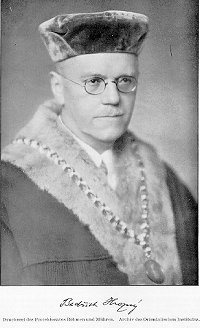Bedřich Hrozný
Bedřich Hrozný, Frederick Hrozny ( born May 6, 1879 in Lissa on the Elbe, † December 12, 1952 in Prague) was an Austrian - Czech linguist and orientalist. He deciphered the written language of the Hittites, and laid foundations for the study of their language and history.
Life
The son of a Protestant minister visited 1889-1896 the Academic Gymnasium in Prague and, after the death of his father for the last school year to the grammar school in Kolin. Especially in Prague, but also in Kolin he acquired his knowledge of Hebrew and Arabic language. He then studied at the Protestant Theological and Philosophical Faculty in Vienna, but dealt very early exclusively with oriental languages (mainly Assyrian, Aramaic, Ethiopic, Sanskrit and Sumerian ). His attention focused primarily on the study of the cuneiform script, which was used in the period from the third to the first millennium BC in the area of Mesopotamia, Asia Minor and the Persian Empire. In 1901 he received his doctorate with a thesis on Sabaean South Arabian Graffiti dedicatory inscriptions. He then went to Berlin for a year to perfect his self-taught skills acquired so far Assyriology at Friedrich Delitzsch.
In 1904 he visited Turkey, Syria and Egypt and made there on copies of cuneiform texts. After his return to Vienna, he worked in the university library. In 1909 he married.
1906-07 a large archive of tablets with cuneiform writing was discovered in an unknown language in Hattusa. Hrozný was one of the persons, who assumed the scientific riddle and presented in the midst of the First World War, the solution of the problem. At the same time he published a short grammatical sketch and showed that it is the language of the Hittites. He also showed that this language belonged to the Indo-European language family and is similar to Greek, Latin, as well as Indian languages.
After the founding of Czechoslovakia in 1918, he was appointed at the Charles University in Prague professor of cuneiform and history of the ancient Near East. In 1924, he received funding for the first Czech expedition to Syria. He found the remains of Greek buildings, pottery and terracotta statues. In 1925 he found about a thousand clay tablets unearthed at Kültepe in Asia Minor. It consisted mostly of contracts or Old Assyrian merchants. In November 1925 he returned to Czechoslovakia.
He held successful talks at numerous universities. In 1929 he founded the Oriental archive. 1939, when the German occupation of Czechoslovakia, he could emigrate. He stayed and was appointed rector of the Charles University. It was proposed in 1940 for a post in the Ministry of Education, but he turned down.
On November 12, 1952, the appointment of a member of the Academy of Sciences was newly established. A month later, he died on 12 December 1952.
Decipherment of the Hittite language
To solve the riddle of Bedřich Hrozný Hittite language used occurring in a text two sets NINDA - to ezzatteni watar -ma ekutteni. No one knew at that time that the ideogram for NINDA in Sumerian meant bread. Hrozný thought that the ending- at perhaps could form the Hittite accusative. Then he assumed that the second word ed-/-ezza could have something to do with the bread and assumed that it was the verb eat. By comparing with the Latin edere, the English eat and eat the German, he came to believe that NINDA - to ezzatteni " ye shall eat the bread " was. In the second set Hrozný dropped the word on watar, which had similarities to the English and the German water water. The last word of the second sentence, ekutteni, had the tribe eku, which was the Latin word aqua (water ) is similar. So he translated the second set as " drink ye water ". On these initial findings, based Hrozný published 1917 Hittite grammar.
Works (selection)
- Sumerian -Babylonian myths of the god Ninrag ( Ninib ). Wolf Peiser, Berlin, 1903.
- Obili ve Staré Babylónií (grain in Altbabylonien ). Hölder in Comm, Vienna 1913.
- The solution of the problem Hittite, In: Communications of the German Oriental Society 56, 1915, pp. 17-50.
- The language of the Hittites, their construction and their belonging to the Indo-European language family. J. C. Hinrichs, Leipzig 1917, TU Dresden, Dresden 2002 ( Neudr ). ISBN 3-86005-319-1
- Hittite cuneiform texts from Boghazkoi, in transcription, with translation and commentary. Hinrichs, Leipzig 1919.
- About the peoples and languages of the ancient Chatti country. Hittite kings. Hinrichs, Leipzig 1920.
- Cuneiform texts from Boghazkoi. Bd 5/6. Autographs. Hinrichs, Leipzig 1921, Zeller, Osnabrück 1970 ( Neudr ).
- Les inscriptions hittites hiéroglyphiques: essai de déchiffrement; suivi d'une grammaire hittite hiéroglyphique s Paradigmes et d'une liste d' hiéroglyphes. Orientální Ústav, Praha 1933.
- About the oldest international migration and the problem of proto- Indian civilization: an attempt to decipher the Proto-Indian inscriptions from Mohenjo -daro. Prague 1939.
- The ancient history of the Near East and India. Melantrich, Prague 1940, 1941, 1943.
- Inscriptions cuneiform you Kultepe. Bd 1 Prague 1952.
- Ancient history of Western Asia, India and Crete. New York 1953.










